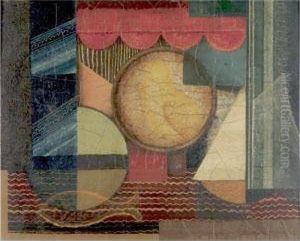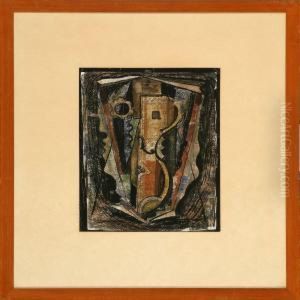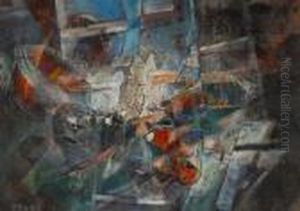Knut Merrild Paintings
Knut Merrild was a Danish-American painter and sculptor, known for his contributions to the modern art movement. Born in Denmark on June 24, 1894, Merrild showed an early interest in the arts, which would lead him to play a significant role in the development of modernist aesthetics, especially within the context of American art. Merrild's journey as an artist began in Europe, but it was his move to the United States in the early 1920s that marked the beginning of his most formative and productive years. Settling in Los Angeles, California, he became part of a burgeoning art scene, engaging with other artists and exploring new artistic directions.
Merrild's work is characterized by a unique blend of European modernist influences and a distinctive exploration of materials and techniques. He was particularly known for his innovative use of the 'pour painting' technique, where paint is poured or dripped onto a canvas, predating similar techniques used by Abstract Expressionists such as Jackson Pollock. Merrild's approach to both painting and sculpture was experimental and avant-garde, reflecting a deep interest in the psychological and metaphysical possibilities of art.
Throughout the 1930s and 1940s, Merrild's work gained recognition in the United States, and he became a pivotal figure in the Los Angeles art community. His exhibitions showcased a wide range of artistic expressions, from abstract paintings to sculptures, and he was celebrated for his ability to transcend traditional boundaries and mediums. Merrild's artistic philosophy was deeply influenced by his friendships with other notable artists of the time, including fellow Dane, the renowned writer and photographer William Mortensen, who shared Merrild's experimental and avant-garde approach to art.
Despite his achievements and contributions to the art world, Knut Merrild remains a somewhat enigmatic figure, often overshadowed by his contemporaries. His death on October 6, 1954, marked the end of a career that had spanned over three decades, leaving behind a legacy that continues to be revisited and appreciated by art historians and collectors. Merrild's work is a testament to the vibrancy and dynamism of early 20th-century modernist art, embodying the spirit of innovation and the perpetual quest for new means of artistic expression. His contributions to the development of modern art, particularly in the United States, underscore the importance of cross-cultural exchanges in shaping the artistic landscape of the time.






